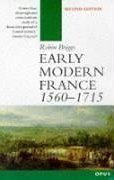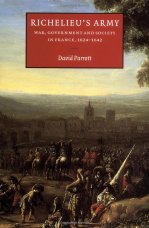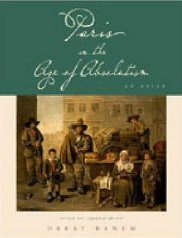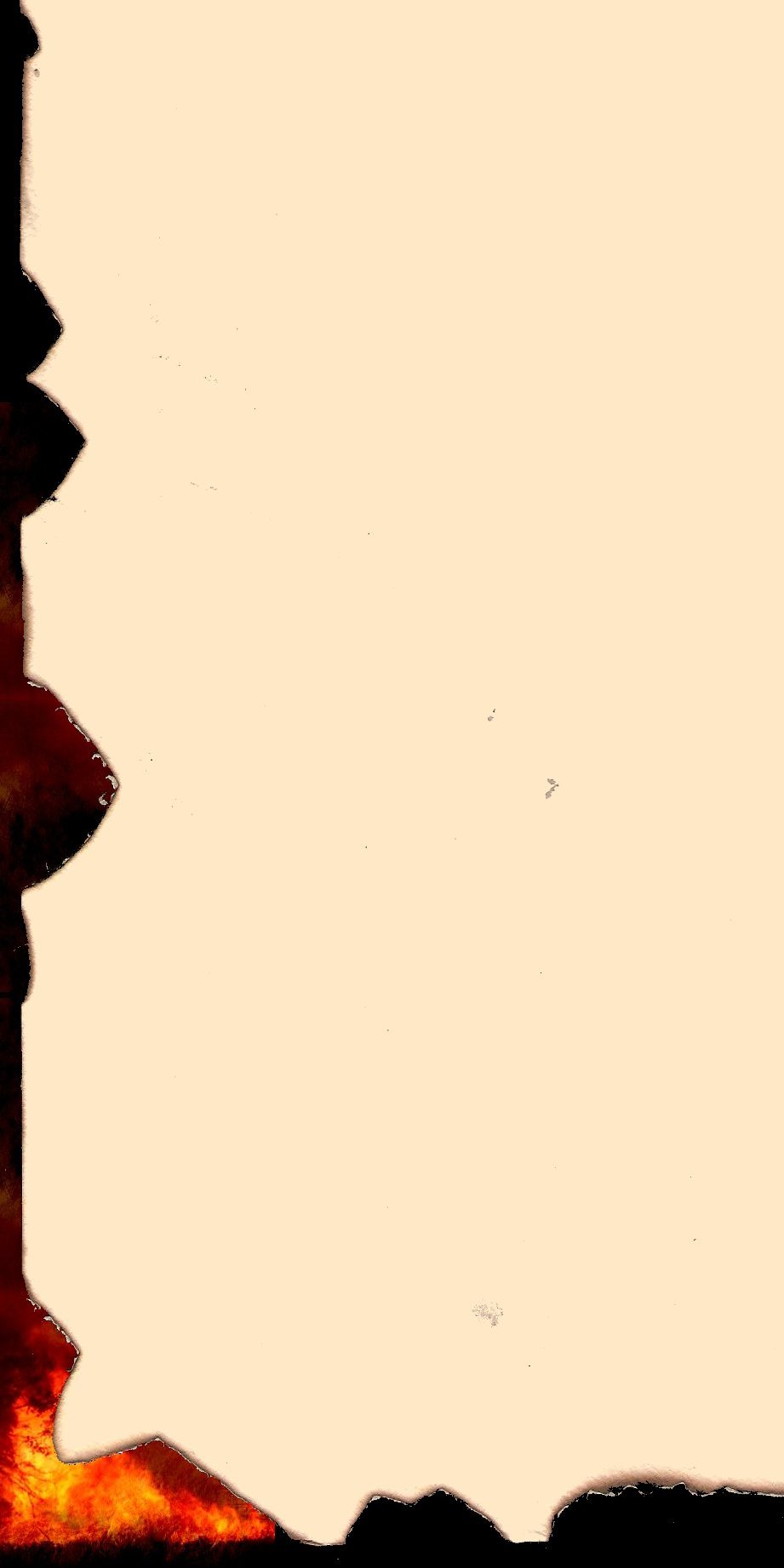![]()
For those interested in the study of 17th century France, there are a vast number of books from which to choose, many still available to buy through Abebooks or alibris if not from Amazon, Blackwells and Waterstones.
| General Histories | |
| War and Military | |
| Social and Cultural Studies | |
| Paris | |
| Primary Sources | |
| Sources — Online Resources |
For an overview of the period, I would particularly recommend:
Early Modern France 1560-1715, by Robin Briggs.
Robin is a Fellow of All Souls College, Oxford, and has helped me a great deal in my work on these documents. Early Modern France is not only a massively insightful and meticulously researched account of the whole period, it is also eminently readable. This is the book that first inspired me to focus on this area, particularly in terms of the later events of André’s life.
The Birth of Absolutism: A History of France 1598-1661 by Yves-Marie Bercé is also highly recommended. Richard Rex’s translation is very clear and easy to read, and the book is a treasure for anyone interested not only in the facts of what happened, but also a sense of what life was truly like. The section on ‘Hopes and Beliefs’ and the details given in the ‘Material Life’ are particularly enlightening for a modern reader wishing to understand the predominant mindsets of the period.
Other useful general histories include An Introduction to Seventeenth Century France by John Lough, which is especially good for those interested in literature of the period, but be warned: many of the sources are quoted only in French. The Seventeenth Century by Jacques Boulenger is sadly out of print, but copies of the English translation can occasionally be picked up, and it’s well worth it. Clear marginal headings keep the reader in control of the material as a whole vast narrative unfolds. This book makes sense of the incomprehensible.
While the ultimate source for any really serious research into the political story of this period must be the Histoire de Richelieu by Gabriel Hanotaux, this has not yet been translated and is extremely difficult (and expensive) to come by. For an overview for the non-specialist or non-French speaker, I would wholeheartedly recommend Richelieu and his Age by Carl J. Burckhardt.

There is a frightening dearth of material on the French military in this period, and even staunch publishers of military history like Osprey tend to concentrate more on Napoleon than anything that preceded him. There are literary sources, however, and one of the best places to find them is Caliver Books (100, Baker Road, Newthorpe, near Nottingham).

They also have an online store with its own special section on Pike and Shot. If Dave and the gang can’t track down that obscure treatise you’re looking for on weaponry of the 17th century, then no-one can.
There are a great many histories of The Thirty Years War, many of them called exactly that. Of these, I would particularly recommend those by C.V.Wedgwood, G. Pagès and Geoffrey Parker.
For those seeking a short summary of the main issues, Stephen J. Lee’s Lancaster pamphlet (also called The Thirty Years War) is particularly clear and concise. For those seeking the best of both worlds, The Thirty Years War 1618-1648 by Richard Bonney is short and simple, but extensively illustrated and represents a definitive work by one of the leading scholars in the field.
Those looking for more detail on specific battles and the weaponry involved would enjoy The Later Thirty Years War by William P. Guthrie, which also includes useful tables on the different types and calibre of firearms, as well as comparing the capabilities of different forms of artillery. The only drawback with this volume is that it does not specify its sources, which makes further research difficult.
A shorter work, but better illustrated and even more helpful on the actual conduct of war is Warfare in the Seventeenth Century by John Childs, which includes detailed diagrams of the firing mechanisms, an excellent account of the use and purpose of pike, and clear maps of different phases of the battles.
The most encyclopaedic work on the subject is European Weapons and Warfare by Eduard Wagner, which is illustrated with the author’s own drawings, but this is weighty and expensive, and can be very difficult to track down.
For those interested in the more human face of war in this period I highly recommend Eyewitness Accounts of the Thirty Years War 1618-1648 by Geoff Mortimer, which explores both military and civilian experiences through the writings of those who were actually there.
All of the above works naturally examine the war as a whole, of which French involvement is only a small part. For those interested in learning more about the French military at this time, I would particularly recommend Richelieu’s Army: War, Government and Society in France, 1624-1642 by David Parrott.
Dr Parrott is a Fellow of New College, Oxford, and another who has both helped and inspired me in my own researches. Richelieu’s Army is a wonderfully comprehensive and detailed analysis of the French military situation at this time, and provides the clearest overall picture of Richelieu’s strategy through the Year of Corbie and beyond. My only gripe with this book is that there is not more of it, and I can only hope there will be another volume to go beyond Richelieu’s death in 1643 and extend the history through to the end of the Franco-Spanish War in 1659.
An essential work for any study of the French army in this period is Giant of the Grand Siècle by John A. Lynn, which deals in great detail with all aspects of army life, from the administration to the business of recruitment and discipline and the day-to-day realities of feeding a vast body of men on the move. This book may make clear some of the attitudes displayed by the ex-soldier Stefan Ravel in Honour and the Sword, and I found it particularly useful in studying André’s own later life in the military. Women, Armies and Warfare in Early Modern Europe, also by John Lynn, provides even more insight into life in the army, especially behind the lines.
I would also recommend French Armies of The Thirty Years’ War by Stéphane Thion, which is an excellent introduction to the subject, and includes English translations of some key eye-witness accounts to the major battles, for instance Gramont on Lens and Freiburg, and Sirot and de la Moussaye on Rocroi. The only weakness is that while the book is beautifully illustrated, some of the paintings are far from contemporary and cannot be taken as reliable indicators of what would have been seen at the time.
A shorter read is The French Army in The Thirty Years’ War by Neil Danskin, which is no more than a thickish pamphlet issued by The Pike & Shot Society, but the author has researched extensively and provides an excellent summary of the main material available on the subject. It also provides a complete Infantry Regimental List for the period, which is invaluable for the serious military enthusiast. This is not entirely error-free in its interpretations – I notice, for instance, that the regiment first known as the Hepburn and later to become the Douglas is marked as ‘possibly Italian’ when it is in fact Ecossais and the very first incarnation of what we now know as the Royal Scots – but the author is very particular to indicate where he is quoting fact and where he is speculating, a rare virtue that enables the reader to proceed in total confidence.
For those interested in life on the other side, the definitive work is undoubtedly The Army of Flanders and the Spanish Road 1567-1659 by Geoffrey Parker. It focuses more on organization and logistics than details of battles, but provides an invaluable insight into life in the tercios at this most crucial time, making sense of the extraordinary dichotomy between the fervent religion and extreme brutality both typically displayed by the Spanish soldier in the Flanders.

There are a great many of these, but in keeping with the ‘New History’ movement, most are more concerned with analysis of particular aspects (especially related to gender issues) rather than giving a comprehensive picture to the uninitiated. Even the definitive Society and Culture in Early Modern France by Natalie Zemon Davis, while essential reading for anyone seriously interested in the period, focuses only on certain specific areas, especially those concerning gender roles.
For those seeking a more general picture, I would recommend A Social and Cultural History of Early Modern France by William Beik, which is no less scholarly, but paints broader strokes and is perhaps more accessible to the non-specialist reader. It is also very well illustrated throughout.
I have personally found it more helpful to my researches to seek out books which deal exclusively with specific areas, as these tend to provide a considerable body of fact as well as analysis. Of these, I would particularly recommend:
For the ideology of the noble hero, which gives perhaps the clearest context to the study of André de Roland, Condé in Context – Ideological Change in Seventeenth-Century France by Mark Bannister.
On the related subject of the period mindset concerning duelling, feuds and violence as a means to a noble end, Blood and Violence in Early Modern France by Stuart Carroll.
Even more specifically on the duel is the brilliantly definitive The Duel by François Billacois. This has been translated by Trista Selous and is now available in English.
For a study of the peasantry and rural life, both The French Peasantry 1450-1660 by Emmanuel Leroy Ladurie and The French Peasantry in the Seventeenth Century by Pierre Goubert.
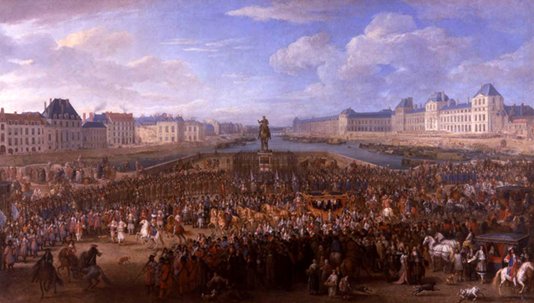
The greatest work on Paris during this time is unquestionably Paris in the Age of Absolutism by Orest Ranum.
The book gives not only factual detail (right down to the furnishings of the famous blue room of Madame de Rambouillet) but also combines a sense of place with a state of mind, from the exercise of charity to the growth of writing outlets for intellectual women. Professor Ranum has been a source of great inspiration to me, as well as generous personal guidance in my work on André’s later life, and I highly recommend a look at his website where he and Dr Patricia Ranum have also posted a number of invaluable translations of rare documents, completely free to anyone who wishes to access them.
Also helpful is City on the Seine: Paris in the Time of Richelieu and Louis XIV, 1614-1715 by Andrew Trout. The approach is less ordered than Ranum’s, but there are some delightful details to be found here, from the system of house numbering to the sounds and smells of the streets. Leon Bernard’s The emerging city: Paris in the Age of Louis XIV is excellent for the general picture, but the emphasis naturally focuses on the period after the 1650's which is a little late for the time of Honour and the Sword.
Perhaps the best illustrated history is the e-book Paris: An Electronic Tour of the Old City by Robert W. Berger. This only contains one chapter on the 17th century, but it is the longest in the book, and provides some wonderful contemporary drawings and engravings of how the city looked in the time of André de Roland, as well as some fascinating primary source material from observers of the day.
If you are going to Paris yourself, there is also the wonderful Paris – Biography of a City by Colin Jones. This has all the appearance of a guide book, and can indeed double as one, but Professor Colin Jones is actually a very eminent scholar indeed and no book does more to place the present experience of Paris in its historical context than this one.
For those happy to read in French, there are also two very fine and well illustrated books which help the modern visitor find the city's history in his surroundings: Paris - Grand Siècle by Nicolas Courtin and Paris - Une Histoire en Images by Pascal Varejka.

Cardinal Retz with his memoirs; © iStock photos
There are a wealth of letters, diaries and memoirs from this period, which still provide the best and most immediate insight into the minds of the men and women who lived it.
Many are now available online, although most have yet to be translated. Those who read in French can find the memoirs of the Cardinal du Retz (Gondi), the elder Brienne, Fontrailles, Montglat, Guy Joly, Pierre Lenet, Turenne, the Duchesse de Montpensier, Madame de Motteville and many others, including Richelieu himself, in different volumes of the Nouvelle Collection Des Memoires pour server a l’Histoire de France collected by Michaud and Poujoulat which have now been digitized by Google.
Some, however, can now be found in English. The Historiettes by Tallemant des Réaux are available in translation, as are the letters of Madame de Sévigné. The translation of Retz’s Memoirs has been digitized by under Project Gutenberg, and others can be bought through reprint publishers such as Kessinger, which has issued the memoirs of Gramont, Mme de Motteville, Saint-Simon and Richelieu. Care, however, needs to be taken with reprints of biographies, which in some cases are highly fictionalized works from the 19th and early 20th centuries. Ninon de l’Enclos and Her Century, for instance, is a wonderful read but sadly almost entirely spurious.
Even where primary source material has not yet been fully translated, it is sometimes possible to read at least extracts in English. La Grande Mademoiselle at the Court of France 1627-1693 by Vincent J. Pitts, for example, makes extensive use of the letters and memoirs of Anne-Marie Louise d’Orléans, Duchesse de Montpensier.
My personal favourite of all the translated texts is Le Cuisinier Français by François Pierre La Varenne, which has been available in English as The French Cook since 1653. If the reader wishes to learn what kind of food the nobility were eating at this time and how it was prepared, this book will certainly inform him. It will not, however, do a great deal for the waistline...
Continued below...
